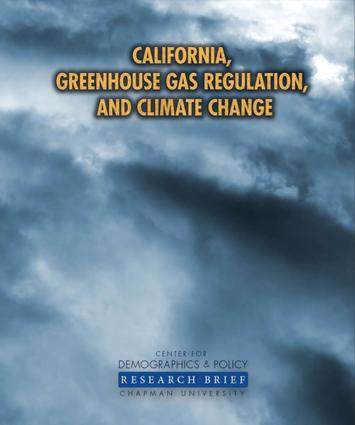
This is an excerpt of a new report, California, Greenhouse Gas Regulation, and Climate Change, from Chapman University’s Center for Demographics and Policy. The report is authored by David Friedman and Jennifer Hernandez, and edited by Joel Kotkin. Read the full report (pdf) using the attachment below.
California has adopted the most extensive climate change policies, laws and regulations in the United States, and the state’s climate leaders are routinely heralded for taking bold and generally unilateral action to reduce greenhouse gas (GHG) emissions within California’s borders to combat climate change. Although California can also claim to be the fifth largest economy in the world if it were a separate nation, the state’s actual GHG emissions account for less than 1% of the world’s anthropogenic GHG emissions. Given the state’s minuscule share of global GHG emissions, Governor Brown has often proclaimed that California’s GHG reductions will be “meaningless” unless other states and countries can be persuaded to follow California’s example.
This paper examines California’s GHG reductions between 2007 (when the landmark Global Warming Solutions Act (AB 32) took effect), to 2017, when the California Air Resources Board adopted the most recent “Scoping Plan” prescribing existing and proposed new GHG reduction mandates (Scoping Plan) that CARB deems required to achieve the state’s legislated mandate of reducing GHG 40% below the state’s 1990 GHG emission inventory by 2030, and the unlegislated Executive Orders issued by the current and prior governor directing the state to achieve an 80% reduction in GHG by 2050.
This paper also examines the performance of California’s economy as experienced by California residents, which presents a substantially different story than the aggregated statewide data used by CARB to conclude the state is enjoying a successful boom. In fact, California has the nation’s highest poverty rate, and by far the largest number of Americans living in poverty: about 8 million Californians, and more than 2 million children, live below the federal poverty level. California also has the nation’s highest homeless rate, and again by far the largest number of homeless Americans, including more than a quarter of a million families, children, and adults. California’s largest city, Los Angeles, counted more than 50,000 homeless individuals in 2017. California has a low unemployment rate, but extraordinarily high costs for basic necessities, including housing, electricity and transportation. For decades, California has also declined to authorize new housing construction, and experts as well as political candidates now concede that California now has a shortfall of about 3 million homes.
Read the full report (PDF) below.
| Attachment | Size |
|---|---|
| California GHG Regulation Final.pdf | 5 MB |












